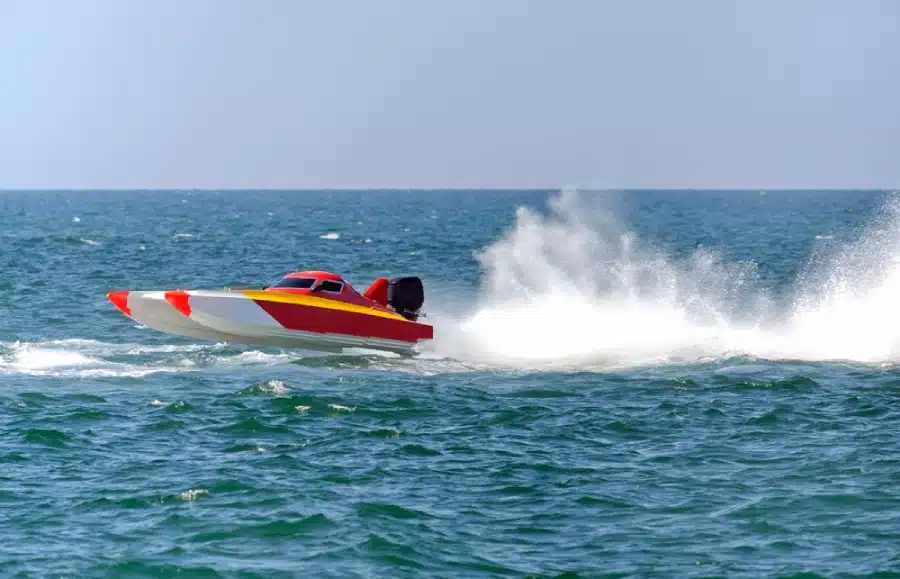
Exposing the secrets behind tilt boat racing’s thrilling twists and turns
Motorboat racing isn’t just about raw speed; it’s also about how racers handle their boats under pressure. One key factor that can make or break a race is tilt—the angle determining how the boat meets the water, affecting speed, stability and control. A perfect change in tilt angle helps racers go faster and stay stable, while a bad one can slow them down or cause risky manoeuvres.
For bettors, understanding this small but crucial detail can give you an edge when predicting which racer is most likely to win. In this guide, we’ll break down what tilt is, how it affects race performance, and what to watch out for so you can place smarter bets on motorboat racing at Sportsbet.io.
Key factors in motorboat racing
Several factors besides speed can affect the performance of motorboats. While it is true that it’s one of the winning elements during a race, there are other important things to consider in motorboat sports betting, such as:
- Turning techniques: How a racer handles sharp turns can make or break their momentum. Smooth, controlled turning keeps speed while avoiding risky skids.
- Weight shifting and balance: Racers often lean or move their weight to keep the boat stable, especially during corners, which helps maintain speed and control.
- Hull lift and planing: When the boat lifts slightly and skims the water surface, it reduces drag and allows faster racing, but too much lift can cause instability.
- The starting dash: A quick, powerful launch at the beginning gives racers an early advantage, often setting the pace for the whole race.
Besides these factors, tilt is another key element bettors should keep in mind when analysing a race, especially how the tilt angle can change the performance and influence the sports betting odds in a bookmaker boat racing.
What is tilt in motorboat racing?
In motorboat racing, tilt refers to the adjustable mounting angle of the motor relative to the boat’s body. This angle usually ranges from about –0.5° to +3.0°, and even the smallest adjustment can change how the boat behaves on the water.
- A negative tilt (angled slightly inward) pushes the bow down. This increases stability and grip, especially in turns, but creates more drag and lowers top speed.
- A positive tilt (angled outward) lifts the bow. This reduces drag and allows higher speed on straights, but makes the boat harder to control in sharp corners.
In short, tilt is all about finding the balance between speed and control. Racers adjust it depending on race conditions, water surface, and strategy. For punters, recognising how tilt influences performance can offer valuable clues about a racer’s approach to the race.
Below is a representation of the possible angles:
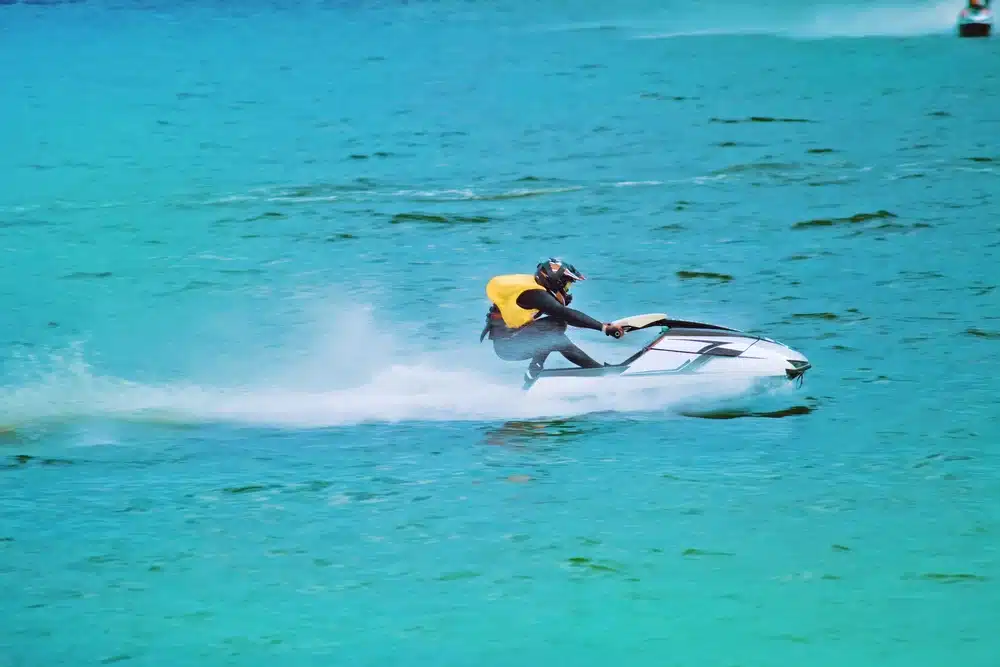
The racer above displays the negative tilt (-0.5 and below), which is a type of tilt used to create better grip by sacrificing aerodynamics.
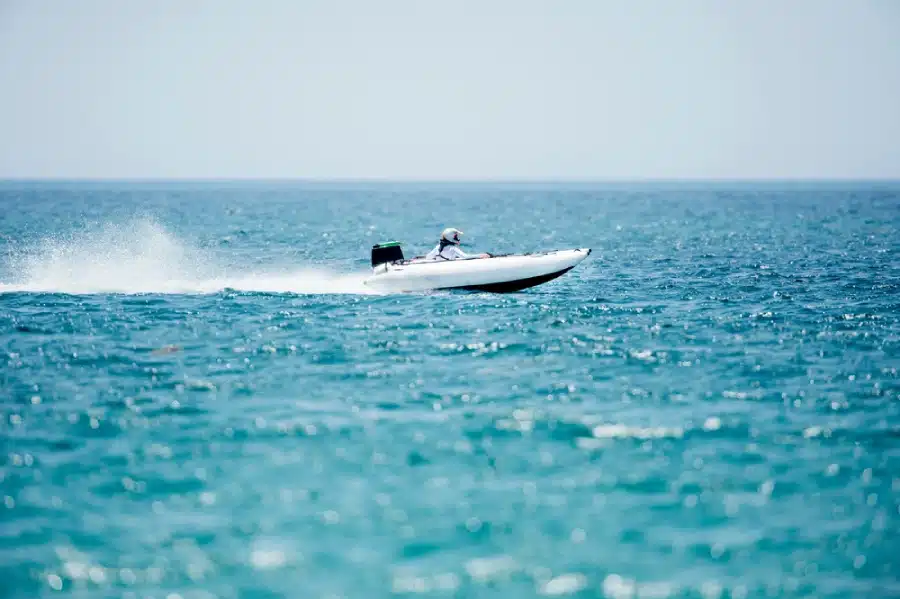
The image above displays a neutral tilt (0.0), which means that the propeller is parallel to the water. It gives a balanced and smooth ride and is usually used in the beginning of the race.
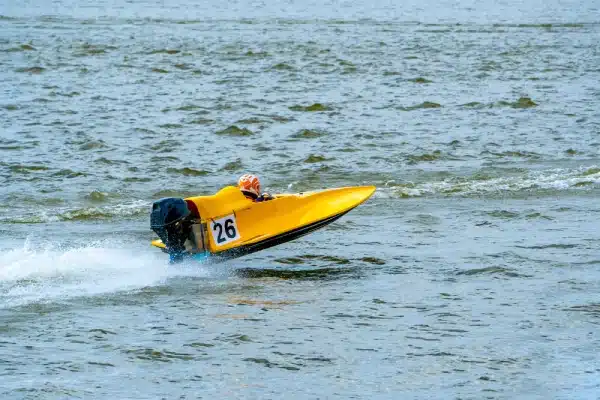
Displayed above is a racer using the positive tilt (+0.5 and up). This gives the racer increased top speed, but in turn, it loses a lot of stability.
Why tilt angle matters for race dynamics and forecasting?
The tilt angle is one of the biggest factors affecting how a race plays out. In short dashes, even a small change in tilt can decide whether a racer pulls ahead or falls behind. Here’s how it affects the race:
- Acceleration (Quick start)
A lower tilt (negative or neutral) keeps the boat’s nose down, which makes the propeller push against the water more strongly. This helps racers get a faster start or pick up speed quickly after a turn.
- Top speed
Tilting the motor slightly up (positive tilt) raises the boat’s nose, so less hull touches the water. This reduces drag and makes the boat faster on straight stretches. However, too much tilt can make the propeller slip, slowing the boat down.
- Turning
When taking sharp corners, racers often use a lower tilt to press the bow into the water. This keeps the boat steady and prevents sliding. Racers risk losing time or control without the correct tilt in a turn.
- Water conditions
On calm water, racers can use a higher tilt to go faster. However, a lower tilt on rough or choppy water helps keep the boat stable and easier to handle.
Knowing how the boat racing tilt angle affects several factors is the key to knowing who has the edge. Positive tilt can boost performance on straights, while lower tilt often wins in tight turns or rough water. Reading these choices helps punters predict outcomes and place smarter bets.
Tips on how to read tilt angles for winning motorboat racing bets
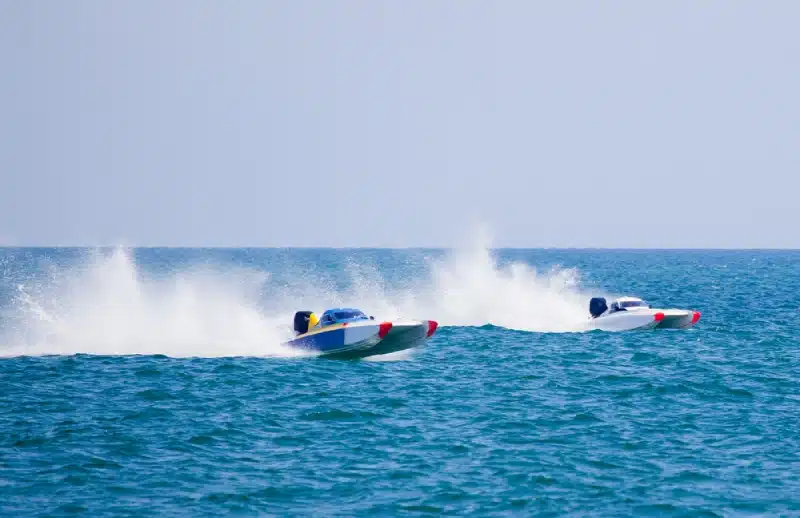
Tilt angles are one of the clearest hints about a racer’s tactics in bookmaker boat racing, and punters who learn how to read them can sharpen their betting strategies. It is a valuable clue, but it should still be seen as just one factor in a broader approach, not a guarantee of success.
Tip 1: Check the posted tilt data
Before each race, tilt angles are published along with other setup details. A higher tilt usually suggests the racer aims for speed on the straights, while a lower tilt points to better control in turns.
Tip 2: Watch the exhibition run
The test run shows how the boat behaves with the chosen tilt. If a racer’s boat lifts the bow more than others, it often signals a setup for acceleration and top speed. If the nose stays low, they may be focused on stability and turning.
Tip 3: Match tilt to the course and water
A higher tilt angle can give an edge on wide courses with long straights. Since a positive tilt focuses on speed, the racers won’t have to deal with sharp turns, which is its weakness. Racers with lower tilt angles usually handle better on tighter courses with many corners or on rough water because they have more grip by sacrificing top speed.
Tip 4: Combine tilt with other factors
Don’t rely on tilt alone. Look at the racer’s start timing, lane draw, and recent form. A quick start secures an early position, lane draw can affect turning angles, and recent form shows consistency. Together with tilt, speed on straights, or stability in corners, these factors give a clearer view of a racer’s chances of winning.
Tip 5: Notice changes on race day
Tilt angles can be adjusted before the main event depending on weather or water conditions. If a racer suddenly shifts from a higher to a lower tilt, it may signal a change in strategy to deal with choppy water or tighter turns.
Tip 6: Compare racers’ tilt choices
Looking at tilt in isolation is useful, but comparing it across all racers in the lineup can reveal bigger insights. If most racers choose low tilt and one racer is using high tilt, that racer may be banking on gaining speed in straights while risking control in corners.
Other factors that affect motorboat racing
Besides tilt, other key elements build the excitement and strategy of motorboat racing. Factors like sharp turning techniques, precise weight shifting, hull lift and planing, and the explosive starting dash all play a big role in how races unfold.
Here’s a closer look at them:
The starting dash
The starting dash is the explosive moment at the beginning of a motorboat race when everyone goes from almost zero to full speed. How well a racer does here can set the tone for the rest of the race. A strong start gives a crucial lead, while a weak one can be hard to recover.
Here are some of the key things racers do and what punters should look for:
- Racers try to time their launch so they cross the start line exactly when the race begins. In Japanese motorboat racing, boats start moving into position as the clock counts down and aim to hit the line at high speed when the clock hits zero.
- Before the final signal, racers are already building speed and adjusting throttle and trim so that when the race starts, there’s no delay. Any hesitation can cost boat lengths.
- The starting dash demands perfect coordination: engine throttle, tilt/trim settings, and body balance must be correct so the boat peaks right as it crosses the line.
Turning techniques
Turning techniques in motorboat racing are all about timing and control. As a racer approaches a corner, they lower the trim and ease off the throttle, allowing the bow to grip the water and the boat to stay steady. During the turn, minor adjustments keep the boat balanced and prevent it from drifting too far to one side.
Once the corner is nearly complete, the racer smoothly adds throttle again and adjusts trim to regain speed on the straight. This ‘slow in, controlled turn, fast out’ method is the core of effective cornering in motorboat racing.
Environmental factors
Water and weather play a big role in motorboat racing. Calm water often allows higher tilt angles and faster speeds, while rough conditions call for a lower tilt for more stability.
Wind can also affect balance and turning, while even small changes in water temperature can influence engine and propeller performance. For punters, noticing how racers adapt to these conditions can be as important as reading tilt angles when predicting race outcomes.
Bet Motorboat races at Sportsbet.io
Sportsbet.io makes betting on motorboat racing simple, fast, and fun. The platform is designed with user-friendliness in mind, so punters can easily find upcoming races, check odds, and place wagers in just a few clicks. Whether you prefer using traditional currency or digital currency, Sportsbet.io offers flexible payment options to suit your style.
With its smooth interface, secure transactions, and reliable support, it’s no surprise that many racing fans consider Sportsbet.io their go-to spot for betting on the action-packed world of motorboat racing.
Master the boat racing tilt angle to improve your bets today
Motorboat racing is a sport where every detail counts, and the boat racing tilt angle is one of the most critical elements of it. Along with turning, weight shifting, hull lift, and the starting dash, these parts work together to make races exciting. Knowing how they affect the race shows the racer’s skill and helps fans enjoy the sport more.
For punters, learning these basics can give an advantage when betting. Seeing how tilt changes speed and control, or how racers handle the start, can give clear clues. With this knowledge, fans can enjoy the action even more while making smarter betting choices. Sign up today and enjoy thrilling motorboat racing at Sportsbet.io.
Frequently asked questions (FAQs)
What is tilt boat racing?
Tilt and boat racing are two separate things. The tilt refers to the angle of the motor compared to the boat’s body. Motorboat racing is a type of racing that uses motorised performance boats.
Which tilt angle is most commonly used?
While tilt angles can range from about –0.5° to +3.0°, the most commonly used settings are between –0.5° and +1.5°. Negative or neutral tilt is often chosen when a course has many tight turns or rough water, as it helps with stability and smooth cornering. On the other hand, positive tilt is more popular on wide courses with long straights, since it improves top speed. Ultimately, the most common tilt angles are those that balance both speed and control, depending on the conditions of each race.
Where can punters check tilt angles?
Tilt angles are usually announced before every race as part of the official setup information. They can be found in race programs, official boat racing websites, and the venue itself. Punters can also see the effects of tilt during the exhibition run (tenji), where racers test their boats on the water before the main event.
Are there promotions or bonuses for betting on motorboat races at Sportsbet.io?
Yes. These can include deposit matches, cashback rewards, free bets, and special event bonuses linked to major races. To stay updated, it’s best to check the Sportsbet.io promotions page, where new deals are posted often. This makes the betting experience not only exciting but also more rewarding.
Can tilt settings change on race day?
Yes. Racers often adjust tilt angles before the official race depending on weather, water conditions, and strategy. That’s why checking the latest posted tilt data is essential—small changes can signal a shift in tactics.
What other factors besides tilt influence motorboat racing?
While tilt is key, other elements like turning techniques, weight shifting, hull lift and planing, and the starting dash shape the race. These factors decide how smoothly and quickly a racer can handle straights and corners.
How does the boat racing tilt angle affect betting predictions?
The tilt angle directly changes how a boat behaves in a race, so punters who understand it can make better predictions. A racer using a higher tilt may aim for speed on straights, while one with a lower tilt might perform better on tight turns or rough water. Recognising these strategies can help punters place smarter bets.
Is tilt more important than start timing?
Not always, but the two factors work closely together. The start timing is often the most decisive part of a motorboat race because races are short, and a strong launch can create an early lead. However, even a racer with a perfect start can struggle if their tilt isn’t suited to the course or conditions.
How does water condition affect tilt choices?
Water conditions are a major factor in choosing the right tilt. Calm water allows racers to lift the bow and use a higher tilt to reduce drag and gain speed on straight sections. In contrast, rough or choppy water forces racers to lower the tilt to keep the bow in the water and maintain stability. Strong currents or wakes from other boats can also influence tilt decisions.
Do different types of boats use different tilt strategies?
Yes. Smaller, lighter boats may respond more dramatically to tilt changes, while heavier boats may need larger adjustments to achieve the same effect. Punters who know the type of boat each racer uses can better interpret tilt angles and predict how the boat will behave during the race.
Are there seasonal patterns in tilt choices?
Sometimes. Racers may adjust tilt based on seasonal water conditions, temperature, or race venue. For example, colder water might lead to a slightly lower tilt to maintain stability, while summer races in calm water favour a higher tilt for speed.















